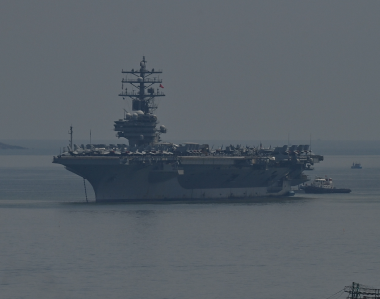By Sherry Chen
- Executive Summary
The Indo-Pacific has emerged as the world’s most strategically significant region, spanning the Indian and Pacific Oceans and containing vital maritime chokepoints such as the Straits of Malacca and Hormuz. The term gained political salience after Japanese Prime Minister Shinzo Abe described the region in 2007 as a “confluence of the two seas,” linking Asia’s key oceanic zones. The United States later adopted the concept as part of its Free and Open Indo-Pacific strategy, which emphasizes freedom of navigation and rules-based order.
The region accounts for nearly half the global population and two-thirds of global GDP, making it a hub for global trade, technology, and energy flows. Strategic interests of major powers—including the United States, China, India, Japan, and ASEAN members—intersect here, shaping a contested yet interdependent environment.
At the core of the region lies a deepening U.S.–China military rivalry. The United States maintains a dominant force posture through alliances and forward deployments, while China expands its maritime reach and pursues strategic influence, challenging existing power structures in the Indo-Pacific.
- United States: The Defender of a Rules-Based Order
Key Military Metrics
The United States ranks first in the Asia Power Index, demonstrating unmatched military capability, defense networks, and future resources in the Indo-Pacific. It maintains global superiority with 11 carrier strike groups, advanced aircraft, and extensive forward-deployed assets. The United States spends over $811 billion annually on defense—more than the next ten countries combined—reflecting its emphasis on strategic dominance. Through initiatives like the Pacific Deterrence Initiative, it reinforces its posture across allied bases in Japan, South Korea, and the Philippines. This sustained investment and presence underscore Washington’s commitment to deterring adversaries and preserving a rules-based order in the region.
Defense Strategy
The United States positions the Indo-Pacific as its strategic “priority theater,” aiming to deter China through robust infrastructure, alliances, and force mobility. It maintains access to over 66 forward-deployed sites across key allies including Japan, South Korea, and Australia, and has expanded this network with 12 new locations since 2011. Through the Pacific Deterrence Initiative, the United States invests billions in military construction and logistics resilience to support rapid deployment. Simultaneously, Washington promotes a “free and open Indo-Pacific” strategy that emphasizes maritime security, international law, and rule-based order. It strengthens deterrence by deepening regional cooperation via bilateral treaties and minilateral frameworks like the Quad. The United States also integrates Coast Guard and cyber capabilities to address non-traditional threats. Together, these efforts reflect a long-term strategy to counterbalance China’s military rise, secure maritime trade, and preserve geopolitical stability across the Indo-Pacific region.
Tactical Operations
The United States conducts a wide range of tactical military operations in the Indo-Pacific to assert presence, deter aggression, and ensure freedom of navigation. It regularly executes Freedom of Navigation Operations (FONOPs) through the South China Sea, directly challenging excessive maritime claims, particularly by China. The United States also engages in joint exercises with regional allies—such as RIMPAC, Balikatan, and Talisman Sabre—to boost interoperability and crisis response. Forward-deployed units operate from strategically positioned bases in Guam, Okinawa, and the Philippines, ensuring rapid military mobility. Tactical integration of air, land, sea, cyber, and space capabilities—under the doctrine of “integrated deterrence”—reinforces U.S. regional dominance. Additionally, the United States utilizes coast guard patrols and maritime domain awareness tools to combat illegal fishing and grey-zone coercion. These operations collectively demonstrate America’s readiness to uphold a rules-based order and counterbalance China’s growing assertiveness.
Foreign Relations
The United States relies on a network of strategic alliances and partnerships in the Indo-Pacific to maintain deterrence, project power, and ensure regional stability. Core allies such as Japan, South Korea, Australia, the Philippines, and Singapore support U.S. operations through basing access, logistics, and operational coordination, though political and legal barriers still constrain deeper sustainment cooperation. RAND researchers identify specific gaps in U.S. logistics capacity that necessitate stronger, formalized partner contributions in areas like fuel supply, maritime lift, and theater sustainment.
However, several Indo-Pacific partners have recently explored closer engagement with China, partly due to uncertainty surrounding U.S. foreign policy. Vietnam, India, and Pacific Island nations have all signaled hedging behavior in response to economic pressure and geopolitical flux. These shifts highlight the urgency for Washington to modernize and integrate its alliance system. By reinforcing joint capabilities, expanding intelligence-sharing, and offering tangible economic incentives, the United States can strengthen partnerships and counterbalance China’s growing influence in the region.
- China: The Architect of Regional Revisionism
Key Military Metrics
China ranks third in the Asia Power Index, reflecting rapid gains in military capability, though it still trails the United States in overall power. It fields the world’s largest standing army and second-largest navy by ship count, with growing blue-water capabilities aimed at projecting regional influence. China spends nearly $300 billion annually on defense, a nearly 900% increase since the 1990s. Despite spending less as a percentage of GDP (1.6%), Beijing invests heavily in missile systems, artificial island bases, and naval expansion. These efforts signal a clear intent to challenge U.S. dominance and reshape the strategic balance in the Indo-Pacific.
Defense Strategy
China has steadily implemented a maritime-centered “Blue Dragon” strategy to counter U.S. influence and expand its strategic reach across the East China Sea, South China Sea, and Indian Ocean. It anchors its defense posture on Taiwan and Sri Lanka—two “unsinkable aircraft carriers”—to dominate chokepoints like the Taiwan Strait and Bay of Bengal. China has constructed militarized artificial islands and enforced the “nine-dash line” to assert territorial control, directly challenging international norms. It also extends its influence through hydropower geopolitics and Belt and Road-linked port infrastructure. By doing so, China intensifies pressure on India and competes with U.S.-led alliances. Ultimately, Beijing seeks to “normalize” its territorial assertions and redefine regional security in its favor under the banner of national rejuvenation.
Tactical Operations
China has actively pursued tactical military operations across the Indo-Pacific to assert dominance and challenge U.S. regional influence. It has deployed artificial islands in the South China Sea, which it has militarized with airstrips, radar systems, and missile platforms to expand its anti-access/area denial (A2/AD) capabilities. China regularly conducts grey-zone operations, including PLA Navy and Air Force drills near Taiwan, Okinawa, and the Senkaku Islands, signaling its readiness to escalate. According to a State Department report, China has expanded its PLA Navy and Air Force capabilities—introducing advanced missiles, submarines, cyber, and space assets—solidifying a forward-operating stance across the region. It has also asserted territorial control by releasing a controversial new map in 2023 and reinforced its nine-dash line claims, defying international rulings. Strategically, China has anchored itself in Sri Lanka and intensified naval activity in the Indian Ocean to pressure India and bypass U.S.-aligned maritime corridors. These tactics aim to reshape Indo-Pacific security norms and undermine American deterrence.
Foreign Relations
China’s strategic presence in the Indo-Pacific relies not on formal alliances but on cultivating bilateral dependencies and economic leverage across the region. Beijing has deepened ties with Cambodia, where it reportedly helped expand the Ream Naval Base, raising concerns about potential PLA access. It has also strengthened relations with Pakistan, a long-time defense partner and the centerpiece of the China–Pakistan Economic Corridor (CPEC). In the Indian Ocean, China secured control of Sri Lanka’s Hambantota Port through a debt-for-lease deal, enhancing naval reach. China has also forged ties with Solomon Islands, signing a controversial security pact in 2022. In Myanmar, Beijing continues to fund infrastructure and supply arms, while in Laos, massive BRI investments have made the country heavily reliant on China. Through these relationships, China expands influence without formal military alliances.
- Comparative analysis of U.S. and China’s military power in the Indo-Pacific
The Indo-Pacific has become the epicenter of strategic competition between the United States and China, with both powers employing fundamentally different approaches to military presence, force projection, and regional influence. The United States sustains a conventional, alliance-driven security architecture aimed at deterrence and rule enforcement, while China pursues an asymmetric, infrastructure-centric strategy to gradually reshape the region’s geopolitical order in its favor. While the United States maintains military superiority in terms of technological capability and global reach, China’s localized assertiveness and economic entrenchment present a credible challenge to American primacy in the Indo-Pacific.
The United States remains the dominant military actor in the region. It ranks first in the Asia Power Index, maintaining the world’s largest defense budget—over $811 billion annually—and 11 carrier strike groups. Its Indo-Pacific posture is reinforced by more than 66 forward-deployed sites across Japan, South Korea, Australia, and the Philippines, with expansions continuing under the Pacific Deterrence Initiative. Through joint exercises like RIMPAC and FONOPs, the United States emphasizes integrated deterrence, combining air, land, sea, space, and cyber capabilities. It also strengthens its presence through alliances like the Quad and AUKUS, embedding its military strategy within a broader framework of multilateral cooperation, legal norms, and maritime security.
In contrast, China’s rise is marked by rapid militarization and strategic ambiguity. While it ranks third in the Asia Power Index, China possesses the world’s largest standing army and second-largest navy by vessel count. Beijing has dramatically increased its defense spending—nearly $300 billion—and focused investments on A2/AD systems, artificial islands in the South China Sea, and missile technologies. Under the “Blue Dragon” strategy, China aims to dominate maritime chokepoints, particularly around Taiwan and Sri Lanka, which it frames as “unsinkable aircraft carriers.” Instead of alliances, China forges economic and security dependencies—expanding the Ream Naval Base in Cambodia, leasing Sri Lanka’s Hambantota Port, and signing a controversial pact with the Solomon Islands.
The contrast is clear: the United States relies on formal alliances, transparency, and mobility to secure a “free and open Indo-Pacific,” while China leverages economic influence, strategic ambiguity, and grey-zone operations to quietly alter the balance of power. Though the United States still holds military supremacy, China’s regional encroachment represents a long-term challenge that cannot be countered through force alone but requires enduring political, economic, and diplomatic engagement.
In conclusion, while the United States leverages superior military capabilities, forward-deployed infrastructure, and a robust alliance network to uphold a rules-based order in the Indo-Pacific, China counters with rapid military modernization, grey-zone tactics, and strategic economic entrenchment aimed at revising regional norms and displacing U.S. influence—setting the stage for an intensifying contest over the future security architecture of the region.
 Sherry Chen is a Research Associate at South China Sea NewsWire (SCSNW), a regional news and analysis platform focused on political, economic, and strategic developments in the South China Sea, and is currently studying in a dual program between Columbia University and Sciences Po Paris.
Sherry Chen is a Research Associate at South China Sea NewsWire (SCSNW), a regional news and analysis platform focused on political, economic, and strategic developments in the South China Sea, and is currently studying in a dual program between Columbia University and Sciences Po Paris.
Bibliography
- Asia Power Index. Lowy Institute. Accessed June 20, 2025. https://power.lowyinstitute.org.
- “Backgrounder: China’s Blue Dragon Strategy for the Indo-Pacific.” Geopolitical Monitor. Accessed June 20, 2025. https://www.geopoliticalmonitor.com/backgrounder-chinas-blue-dragon-strategy-for-the-indo-pacific.
- “China’s ‘Blue Dragon’ Strategy vs US Containment Policy.” Stratheia. Accessed June 20, 2025. https://stratheia.com/chinas-blue-dragon-strategy-vs-us-containment-policy.
- “China’s Military Aggression in the Indo-Pacific Region.” U.S. Department of State (2017–2021 Archive). Accessed June 20, 2025. https://2017-2021.state.gov/chinas-military-aggression-in-the-indo-pacific-region.
- “China’s ‘Blue Dragon’ Strategy in the Indo-Pacific.” The Strategist (Australian Strategic Policy Institute). Accessed June 20, 2025. https://www.aspistrategist.org.au/chinas-blue-dragon-strategy-in-the-indo-pacific.
- “Focus on Indo-Pacific.” U.S. Department of Defense. Accessed June 20, 2025. https://www.defense.gov/Spotlights/focus-on-indo-pacific.
- “Indo-Pacific.” Encyclopaedia Britannica. Accessed June 20, 2025. https://www.britannica.com/place/Indo-Pacific.
- “Military Expenditure by the US, China and Russia.” Statista. Accessed June 20, 2025. https://www.statista.com/chart/16878/military-expenditure-by-the-us-china-and-russia.
- “Strengthening U.S. Alliances in the Indo-Pacific.” Foreign Policy Research Institute, March 2025. Accessed June 20, 2025. https://www.fpri.org/article/2025/03/strengthening-us-alliances-in-the-indo-pacific.
- “Sustaining U.S. Military Operations in the Indo-Pacific.” RAND Corporation. Accessed June 20, 2025. https://www.rand.org/pubs/research_reports/RRA2434-3.html.
- “Unpacking China’s Naval Buildup.” Center for Strategic and International Studies (CSIS). Accessed June 20, 2025. https://www.csis.org/analysis/unpacking-chinas-naval-buildup.
- “U.S. Defense Infrastructure in the Indo-Pacific: Background and Issues for Congress.” Congressional Research Service. Accessed June 20, 2025. https://www.congress.gov/crs-product/R47589.
- “2025 Military Strength Ranking.” Global Firepower. Accessed June 20, 2025. https://www.globalfirepower.com/countries-listing.php#google_vignette.
- “What Is the U.S. Strategy in the Indo-Pacific?” Wilson Center YouTube Channel. Accessed June 20, 2025. https://www.youtube.com/watch?v=Z_xpV2wMa_Y.
- Zhang, Derek. “Are America’s Indo-Pacific Friends Flirting with China?” RAND Corporation, May 2025. Accessed June 20, 2025. https://www.rand.org/pubs/commentary/2025/05/are-americas-indo-pacific-friends-flirting-with-china.html.


